"Echoes of Silence: Gazes Across the Strait" examines the enduring tensions in the Taiwan Strait, a geopolitical flashpoint between Kinmen, Taiwan, and Xiamen, China. Documented from July 2022 to July 2024, this project reflects on Kinmen’s pivotal role during the 1950-1970 Taiwan Strait Confrontations between the Kuomintang (KMT) and the Communist Party of China (CPC) and explores how the legacy of that conflict continues to shape present-day political dynamics.
Kinmen’s strategic location made it a critical point during the Taiwan Strait conflict, serving as a shield for the KMT and a key target for the CPC. For the CPC, Kinmen was seen as a stepping stone to seizing Taiwan; for the KMT, it symbolized their determination to defend the frontlines of the Republic of China and their unwavering resistance. This contested history remains etched into Kinmen’s landscapes and collective memory.
This project was inspired by the parallels between the Taiwan-China conflict and other global struggles, such as Russia's invasion of Ukraine and the violence in Gaza, where smaller regions are caught in the power dynamics of larger nations. These reflections motivated my return to Kinmen in 2022 to document its physical and emotional remnants of war. As a Taiwanese, revisiting these landscapes became an urgent exploration of the human cost of conflict and a plea for lasting peace.
Presented through a multi-dimensional installation—including a broadcast wall, a clay map, textured wall surfaces, and Coptic bounding books, blending contemporary moments with historical narratives. Structured in three chapters—We Spy on Them, and They Spy on Us, Counterattack the Mainland, and There Is No True Victor in War—the project uses photography to reflect on surveillance, resilience, and the shared burden of memory. Through this exploration, I aim to provoke dialogue about the enduring effects of war and the urgent necessity for peace in the Taiwan Strait.
Chapter 1: We Spy on Them, and They Spy on Us

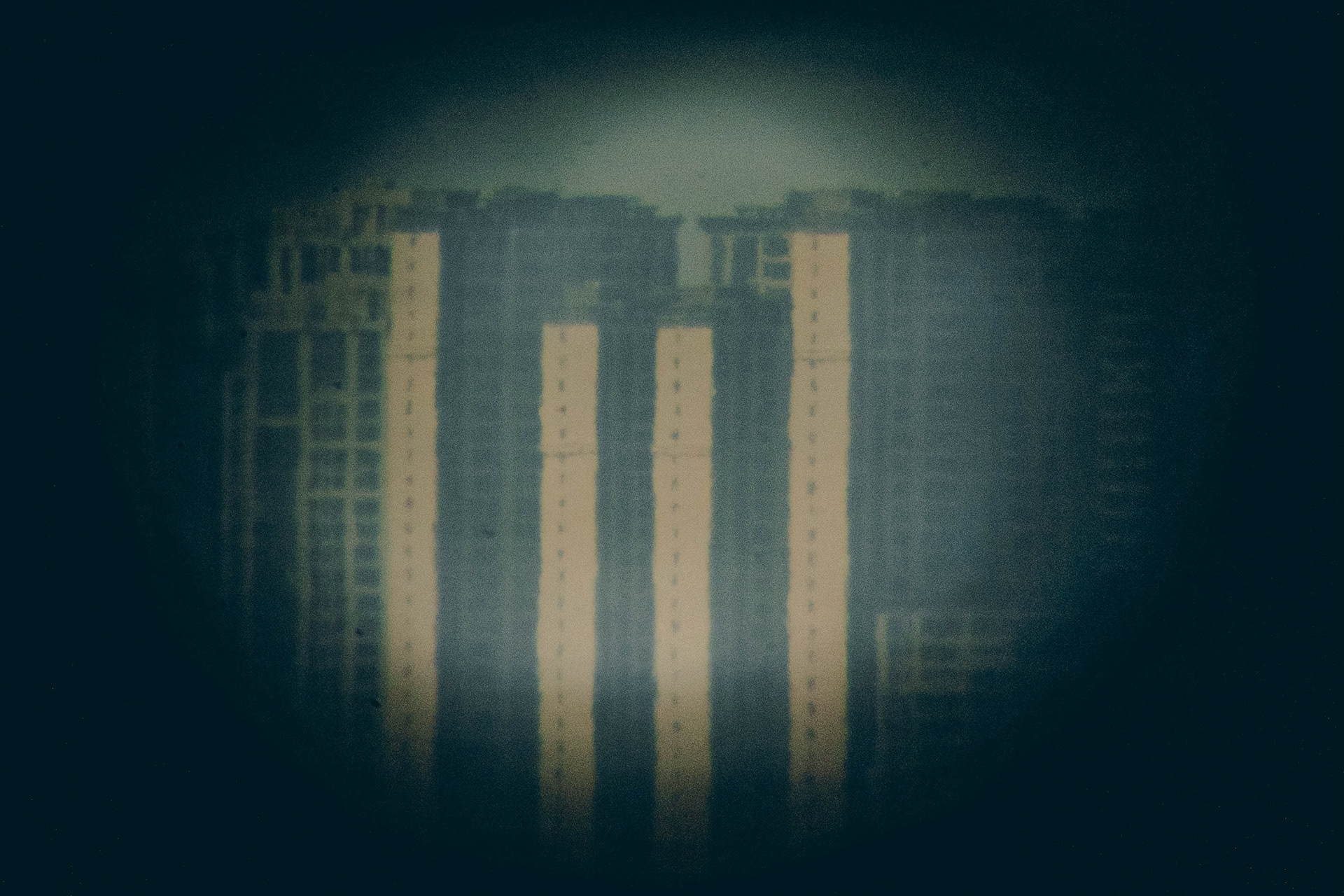
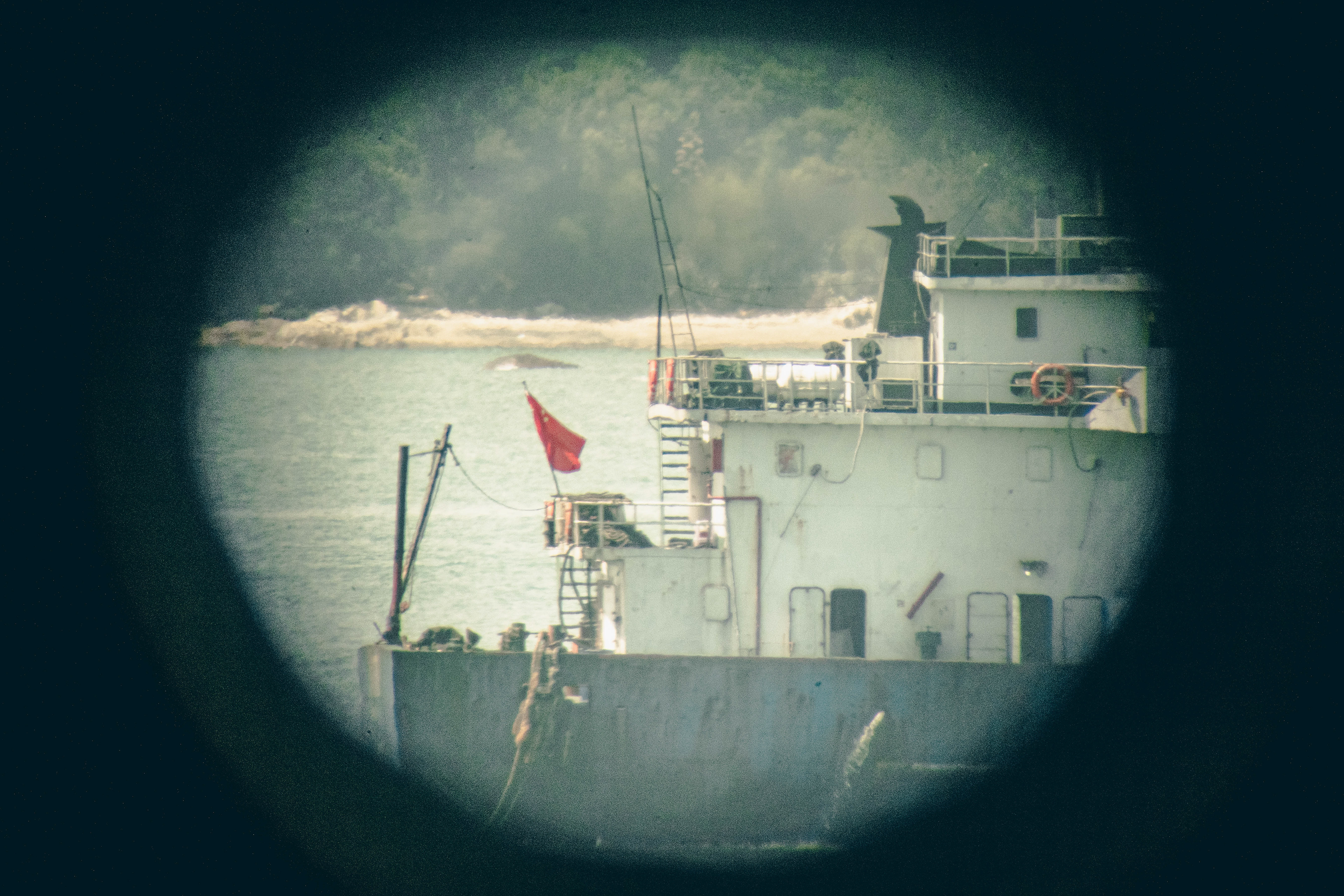

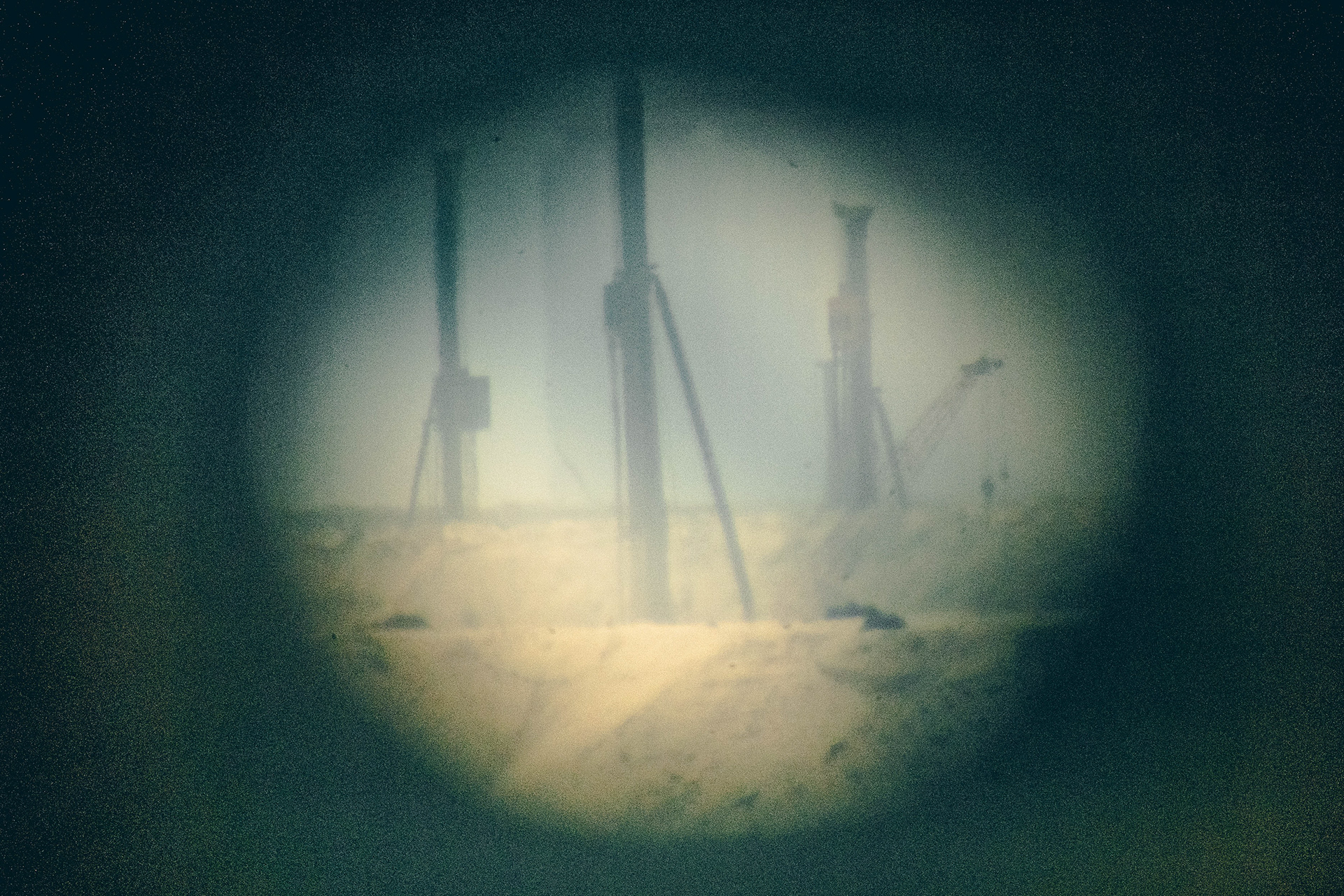
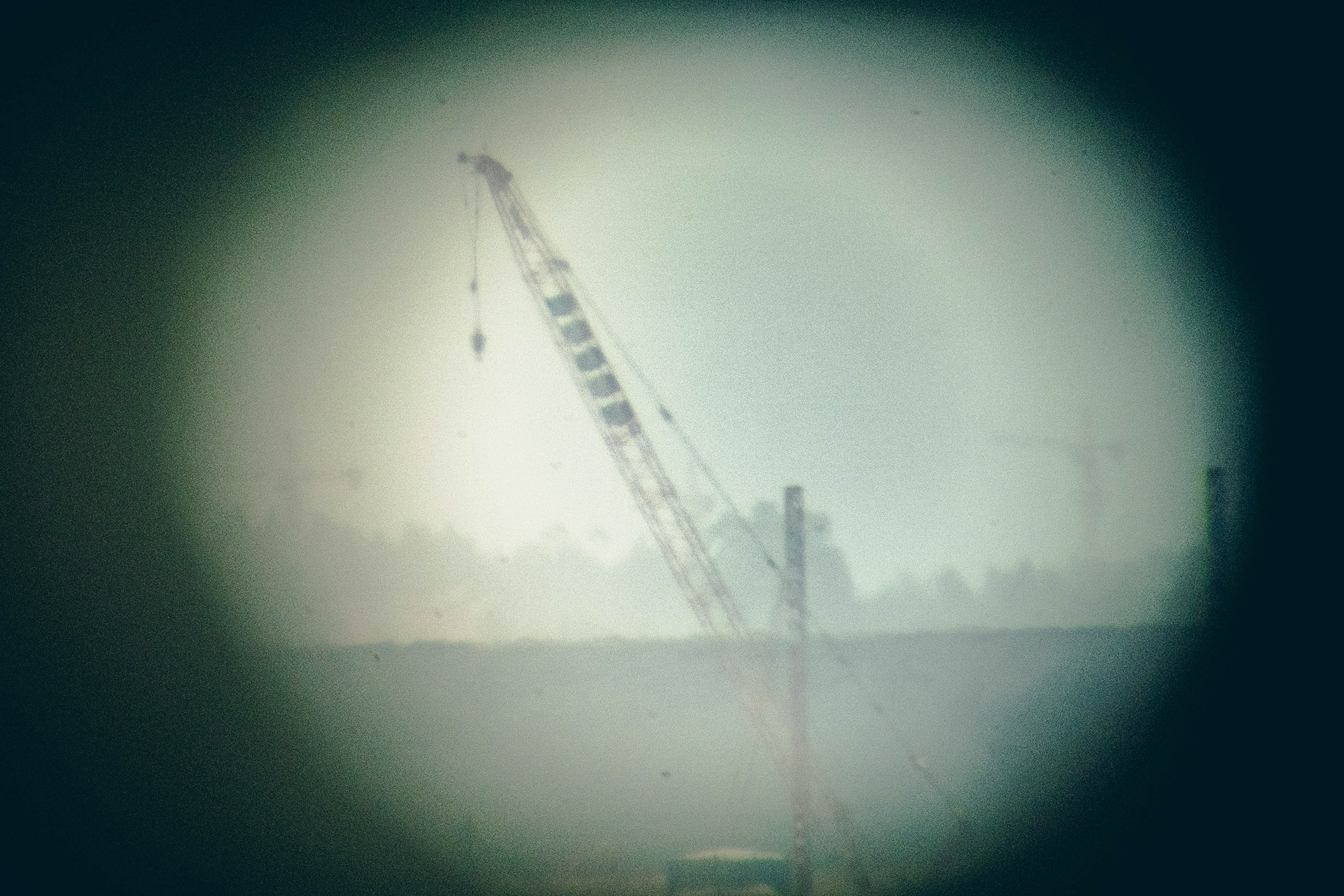
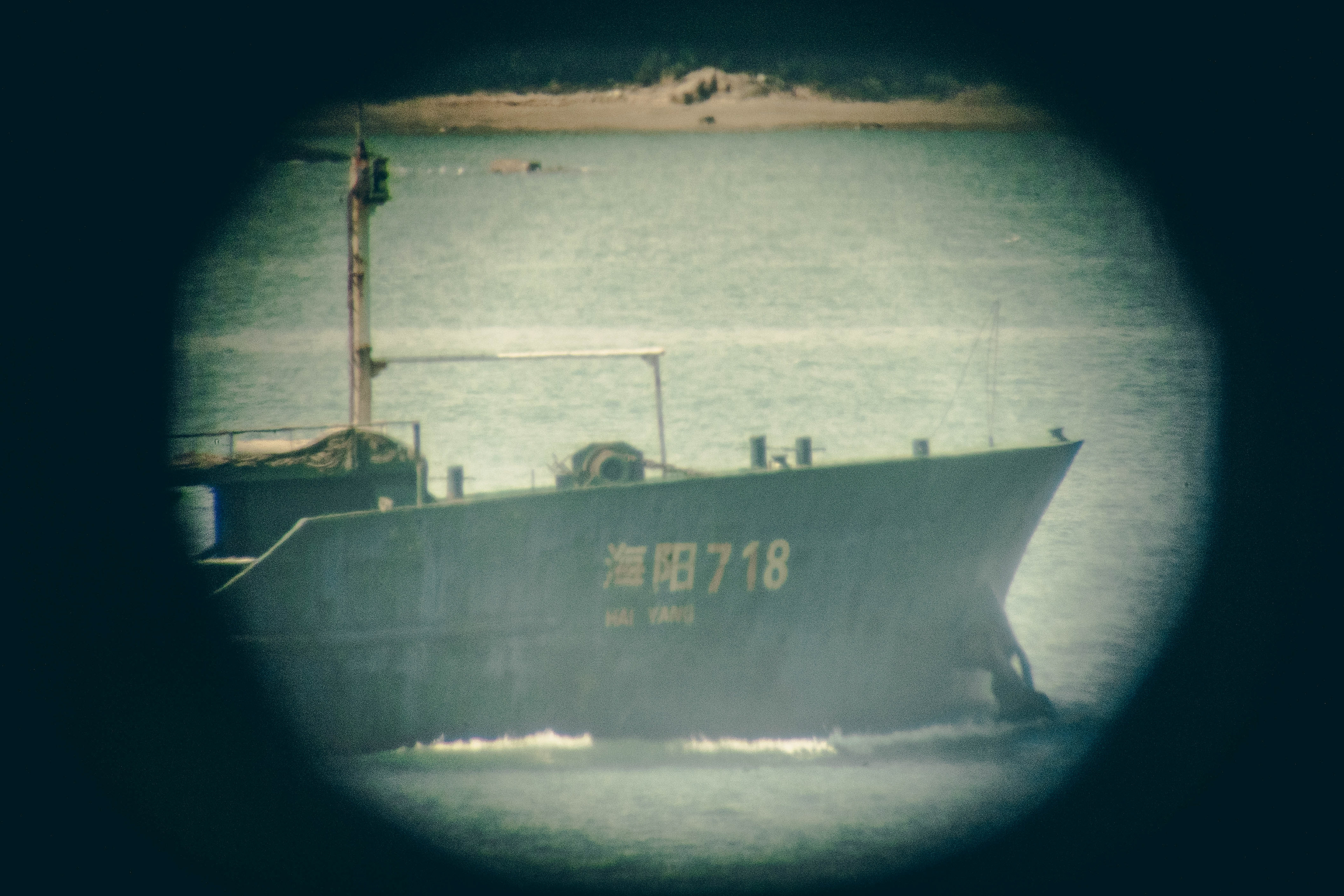
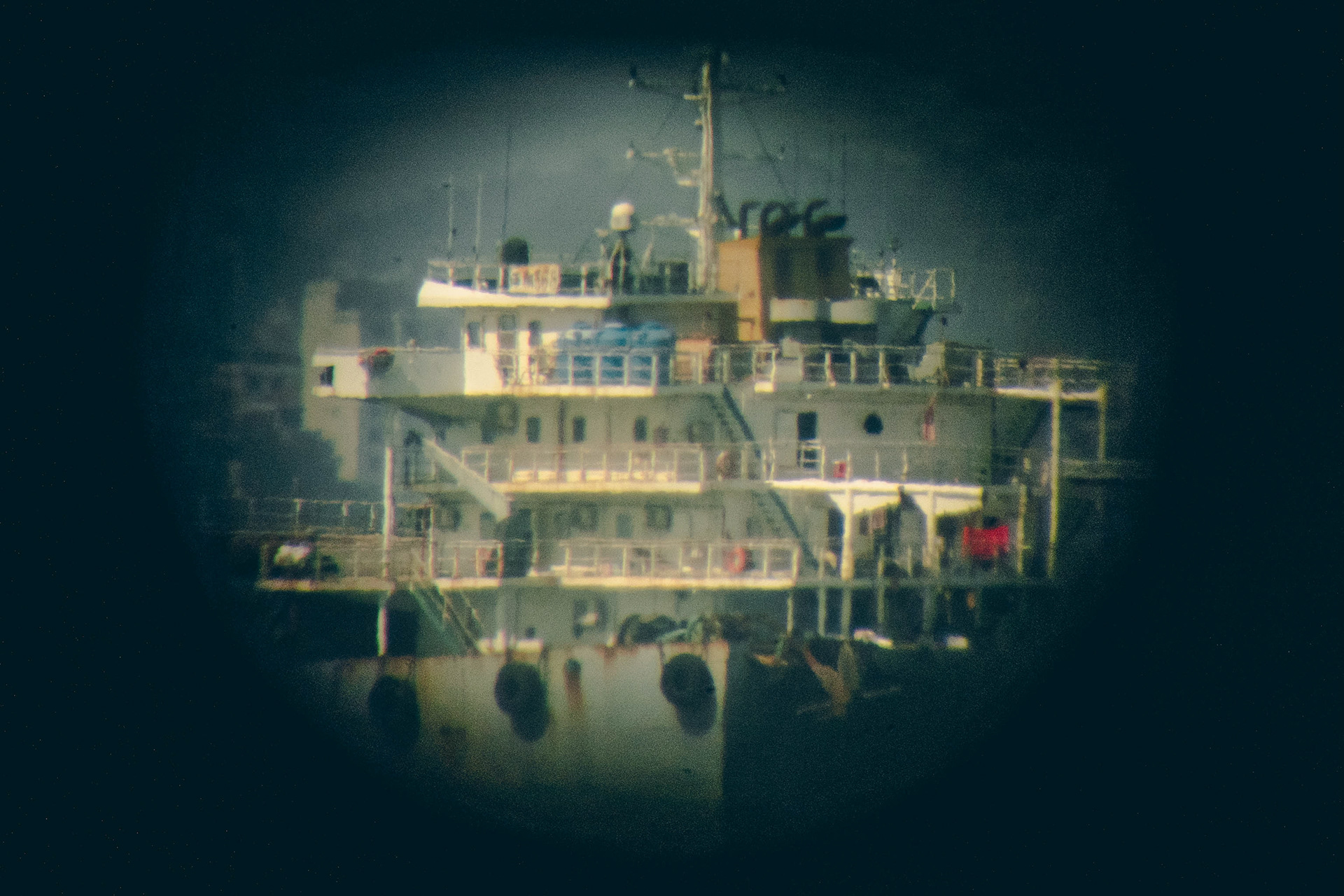
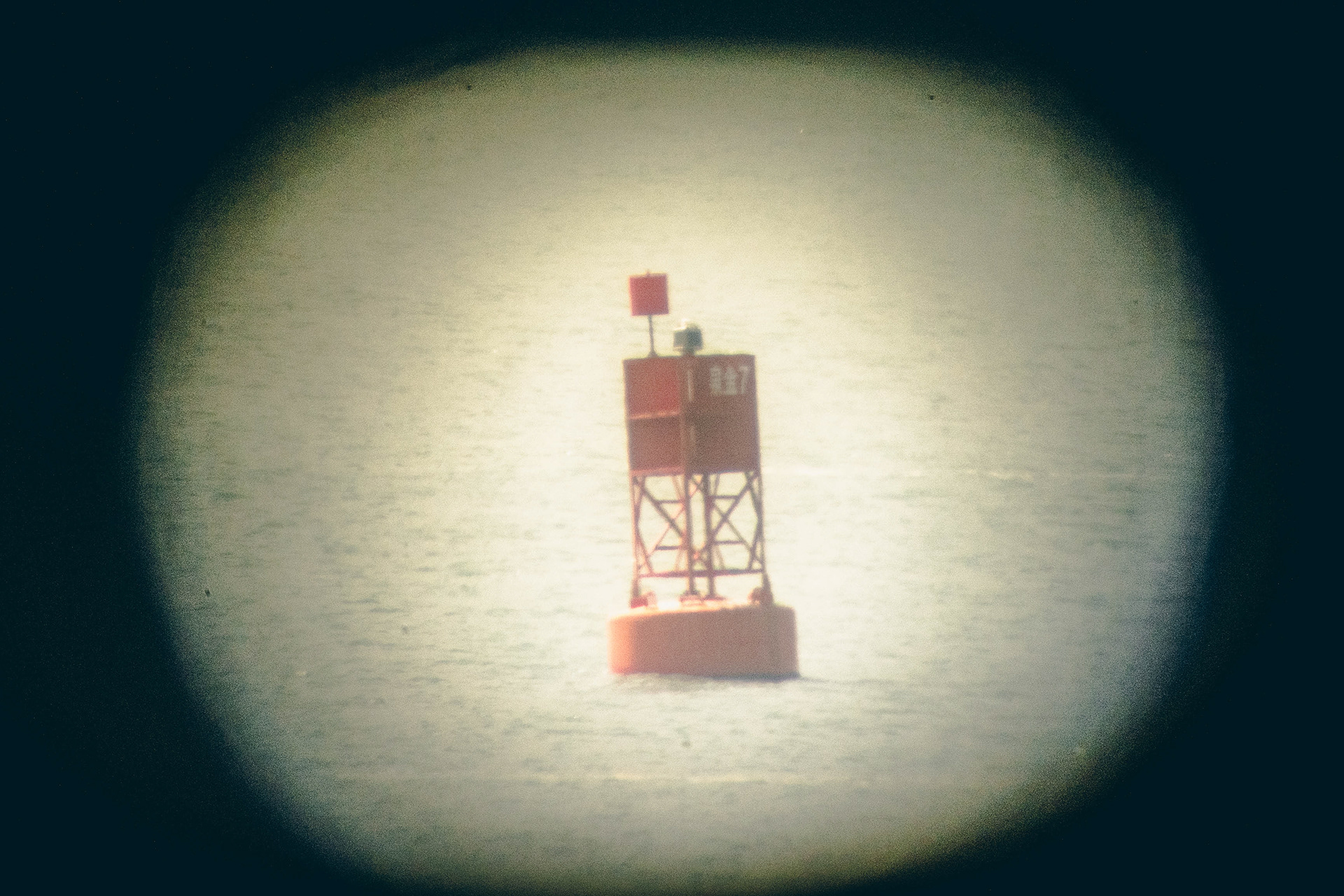
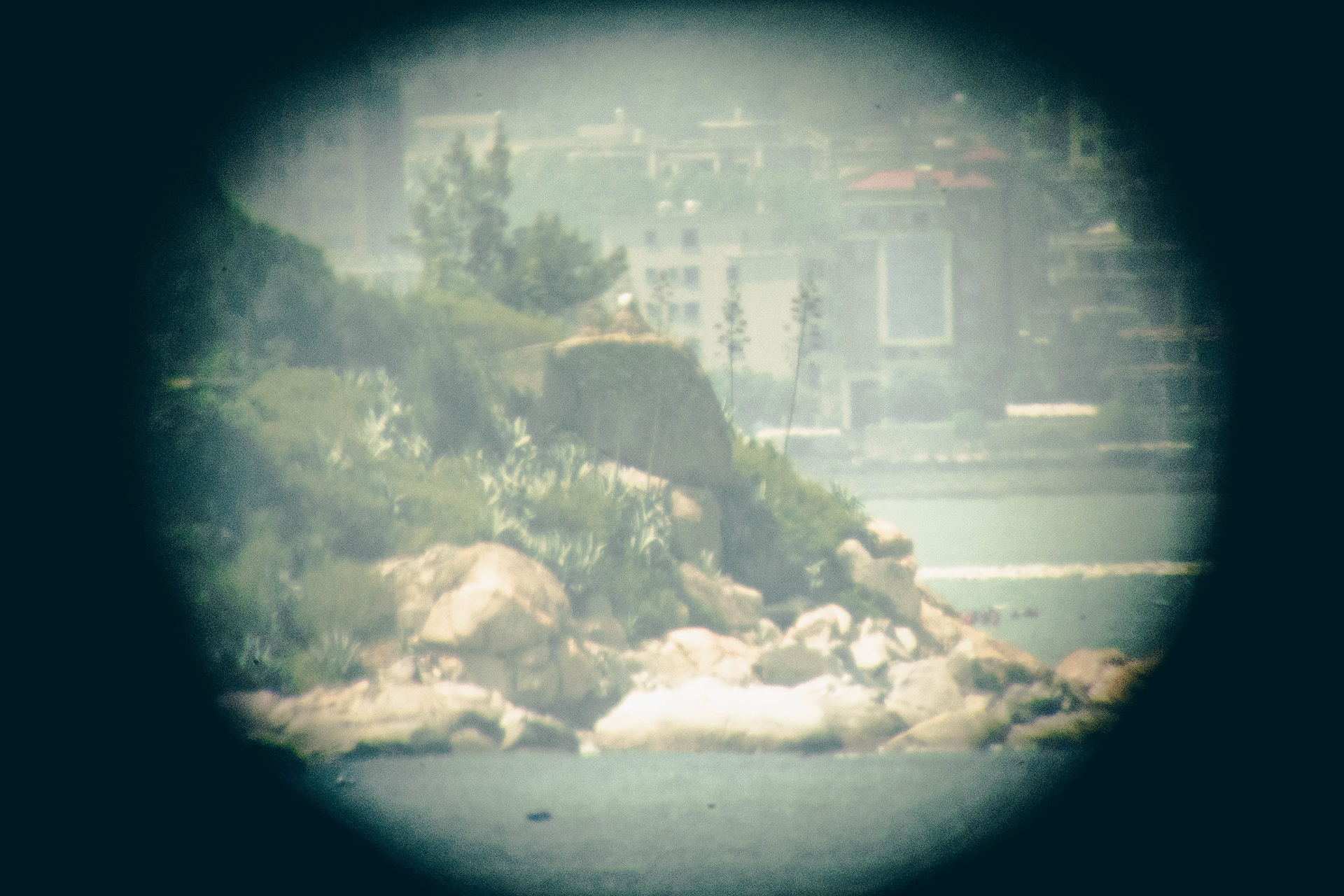
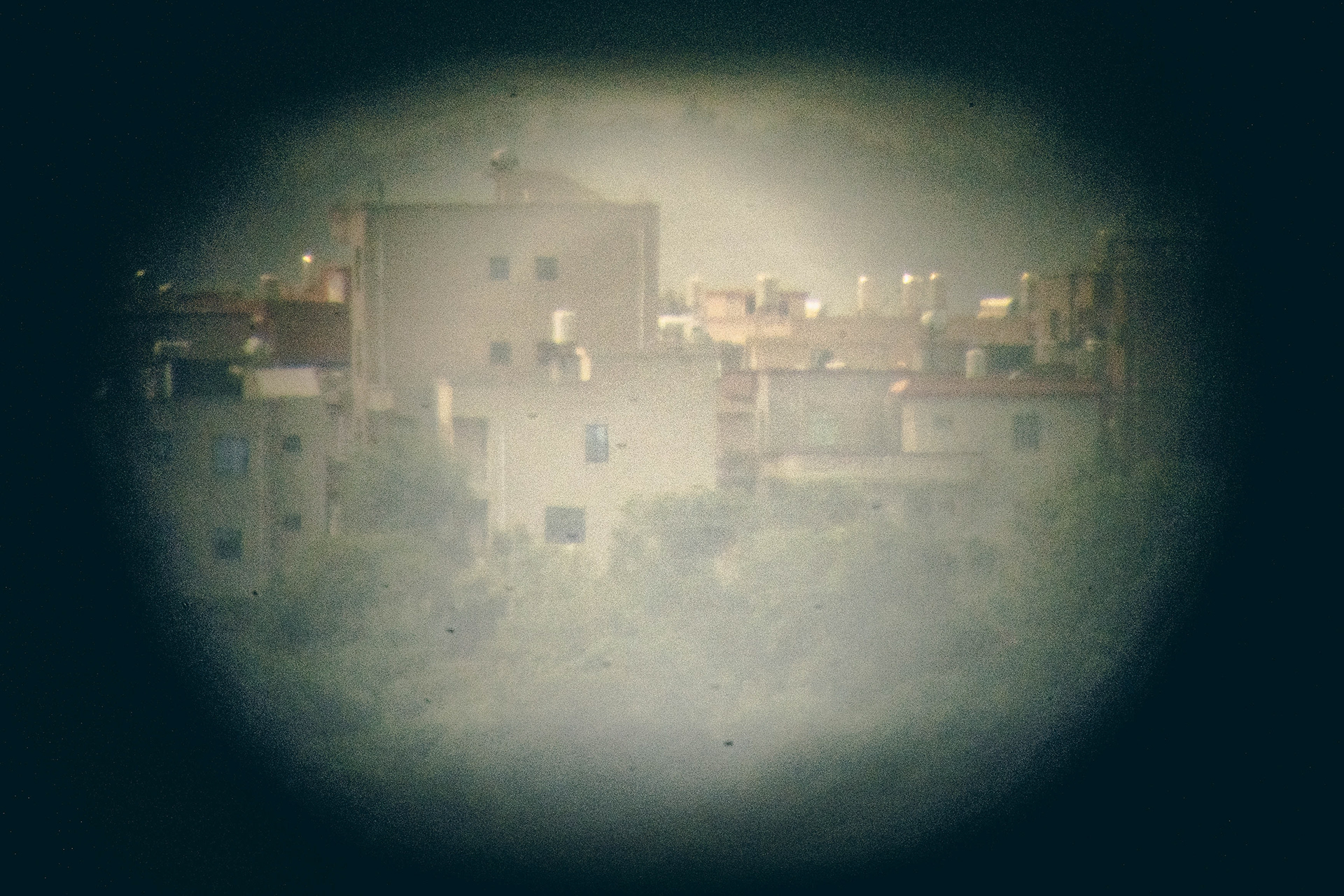
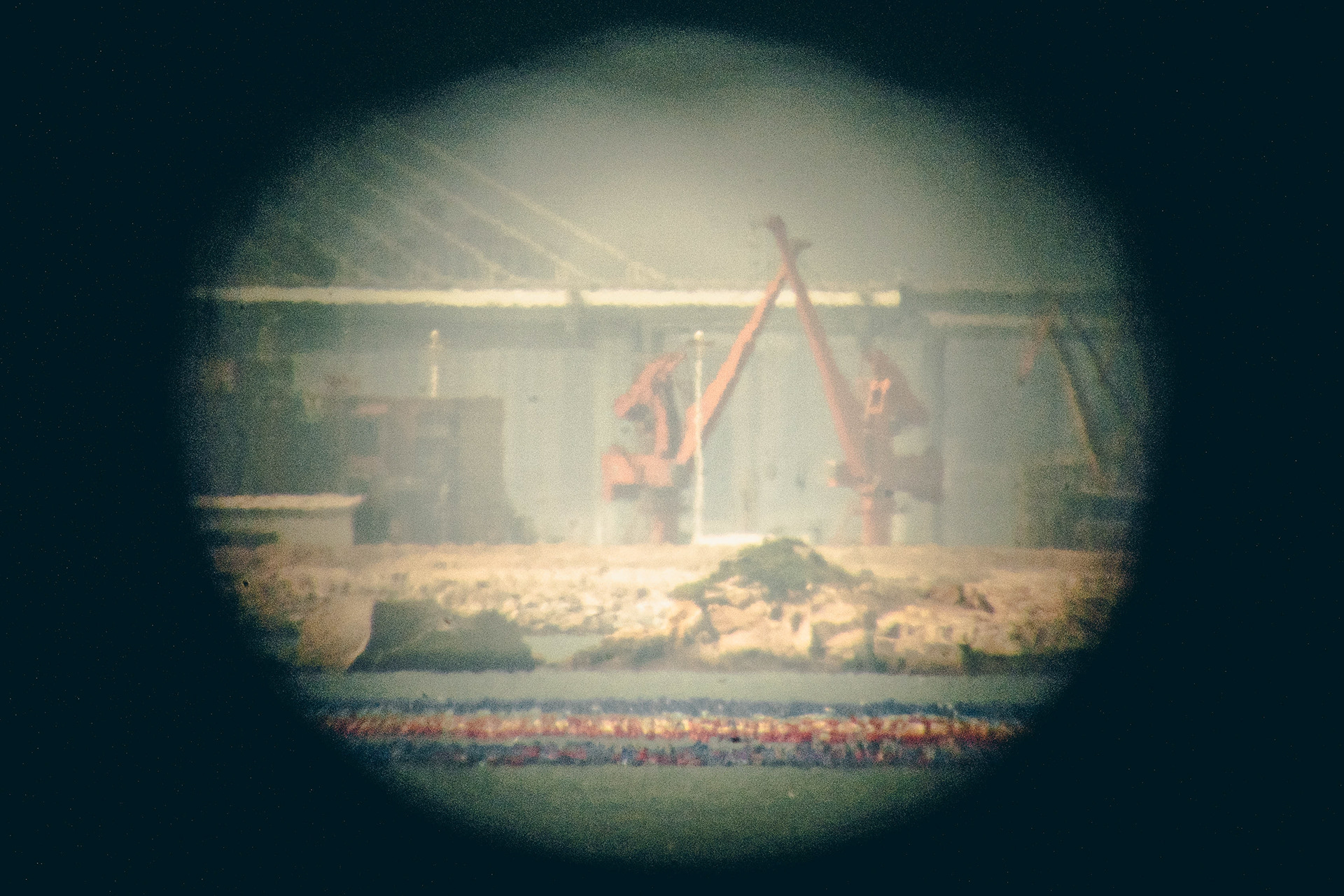
These images were taken from the Mashan Military Observation Post in Kinmen, where I photographed Xiamen across the Taiwan Strait, capturing scenes of what remains sixty years after the Taiwan Strait Confrontation ended. The contents of the photographs include residential buildings, sand dredging vessels, the ongoing construction at Xian’an Airport, and the Xiamen Military Observation Post. I focused on using binoculars to capture a closer view of the distant landscape. This act of using binoculars is not just a technical choice but also a metaphorical gesture. It transforms the act of observation into a form of surveillance, mirroring the tension between Taiwan and China, where each side watches the other from a distance. This dynamic reflects the larger geopolitical reality of the region, where surveillance is not only a means of gathering information but also a mechanism for asserting power, control, and a sense of proximity despite physical and political separation.
Chapter 2: Memory and Identity - Counterattack the Mainland
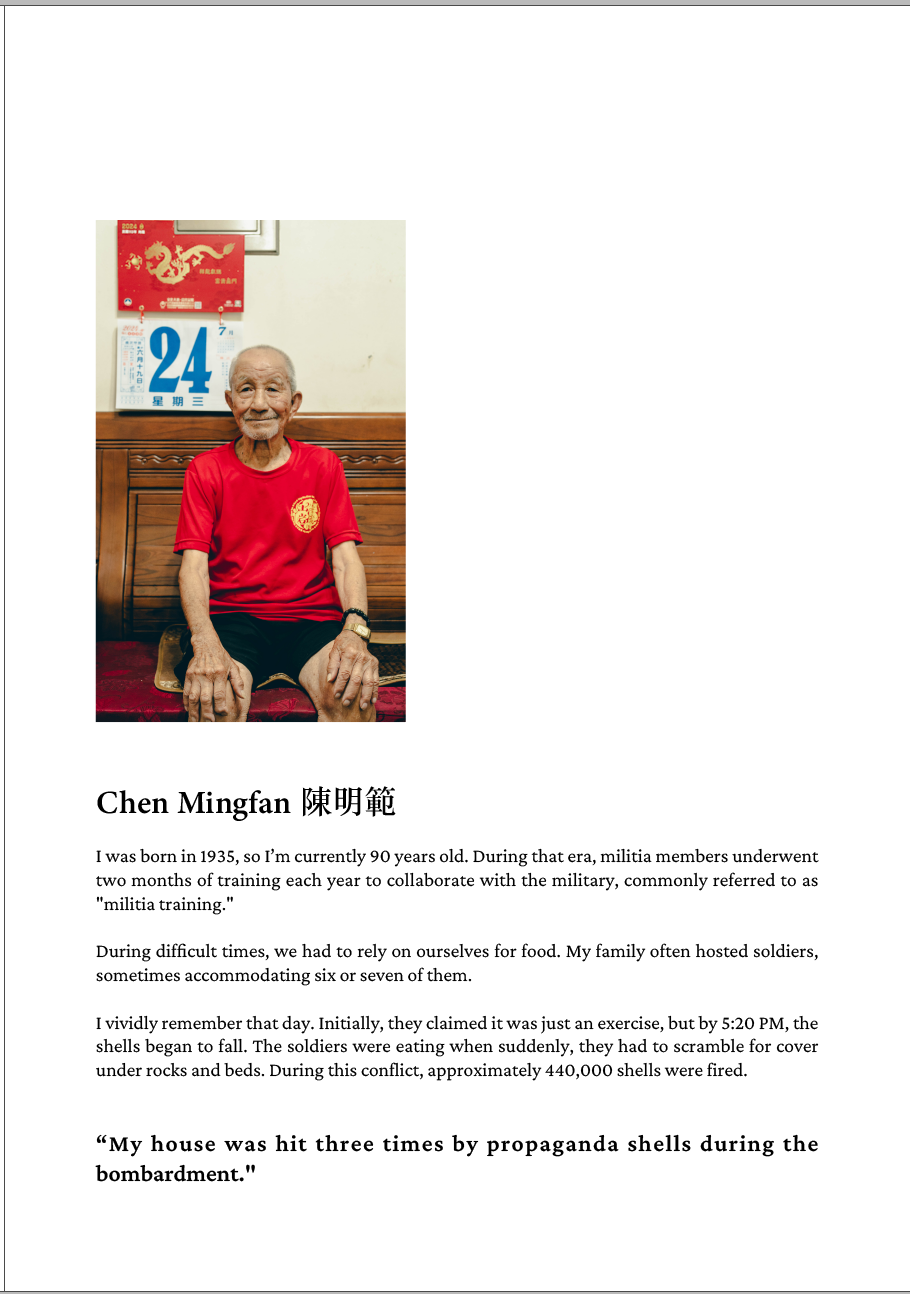
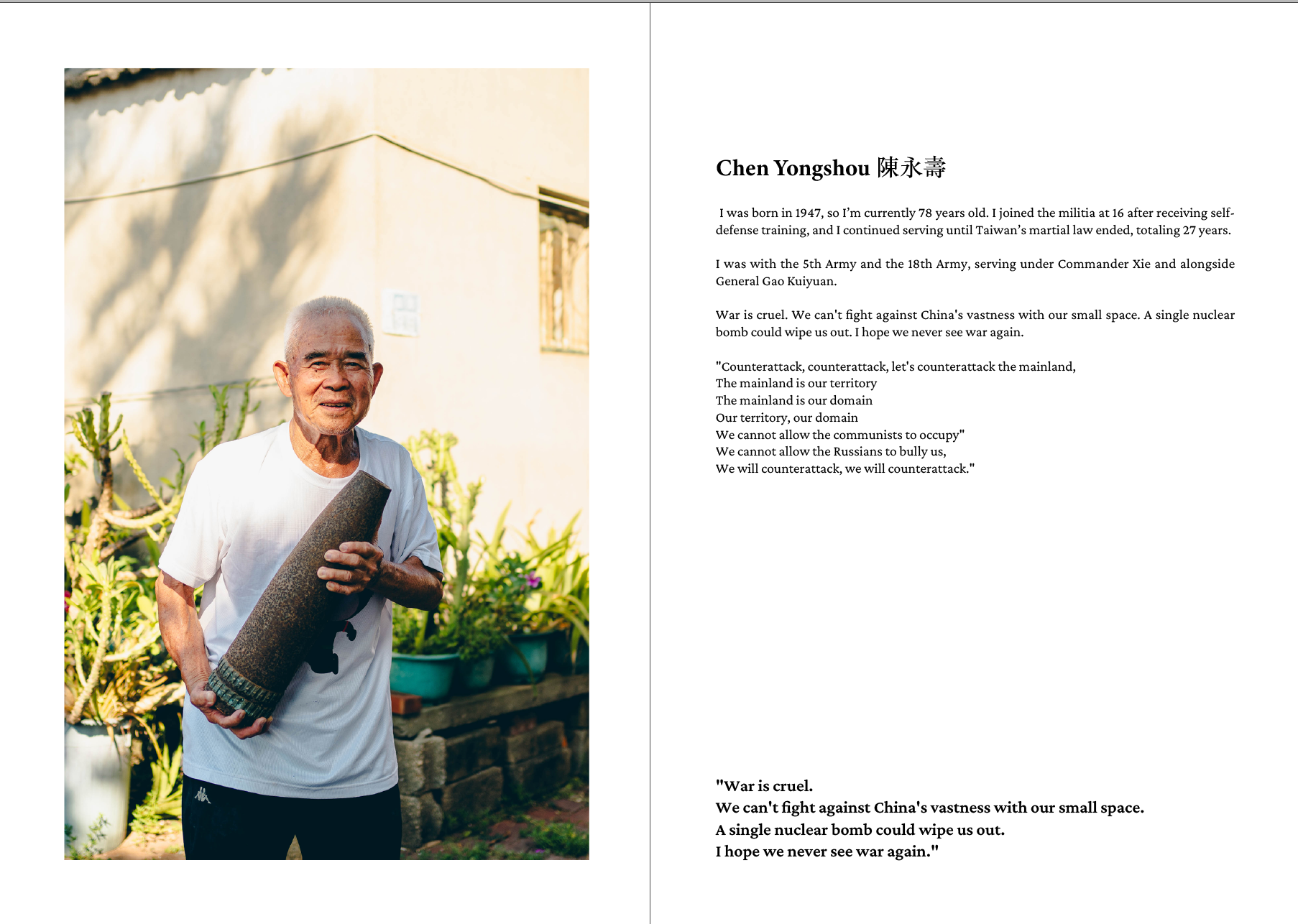
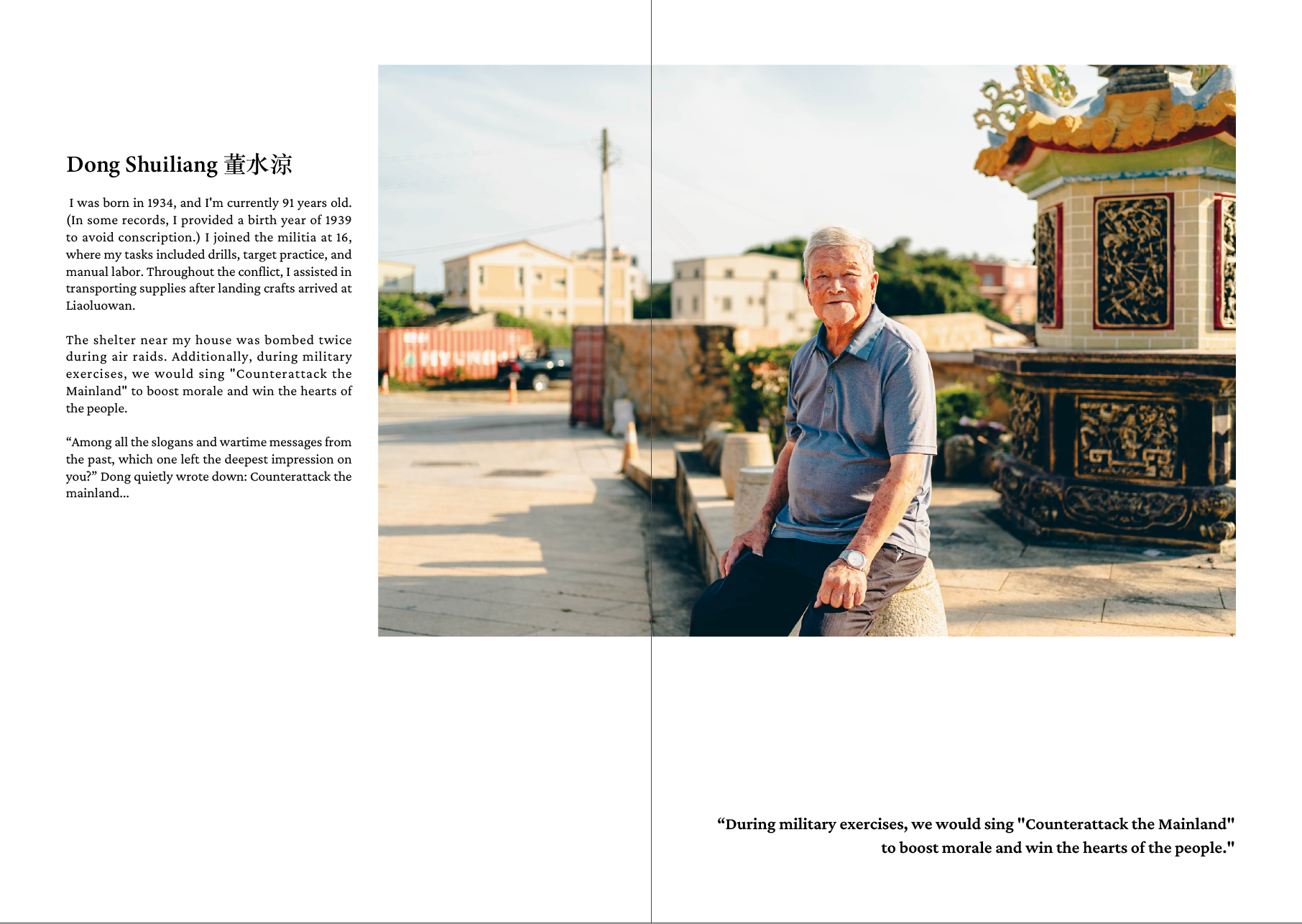
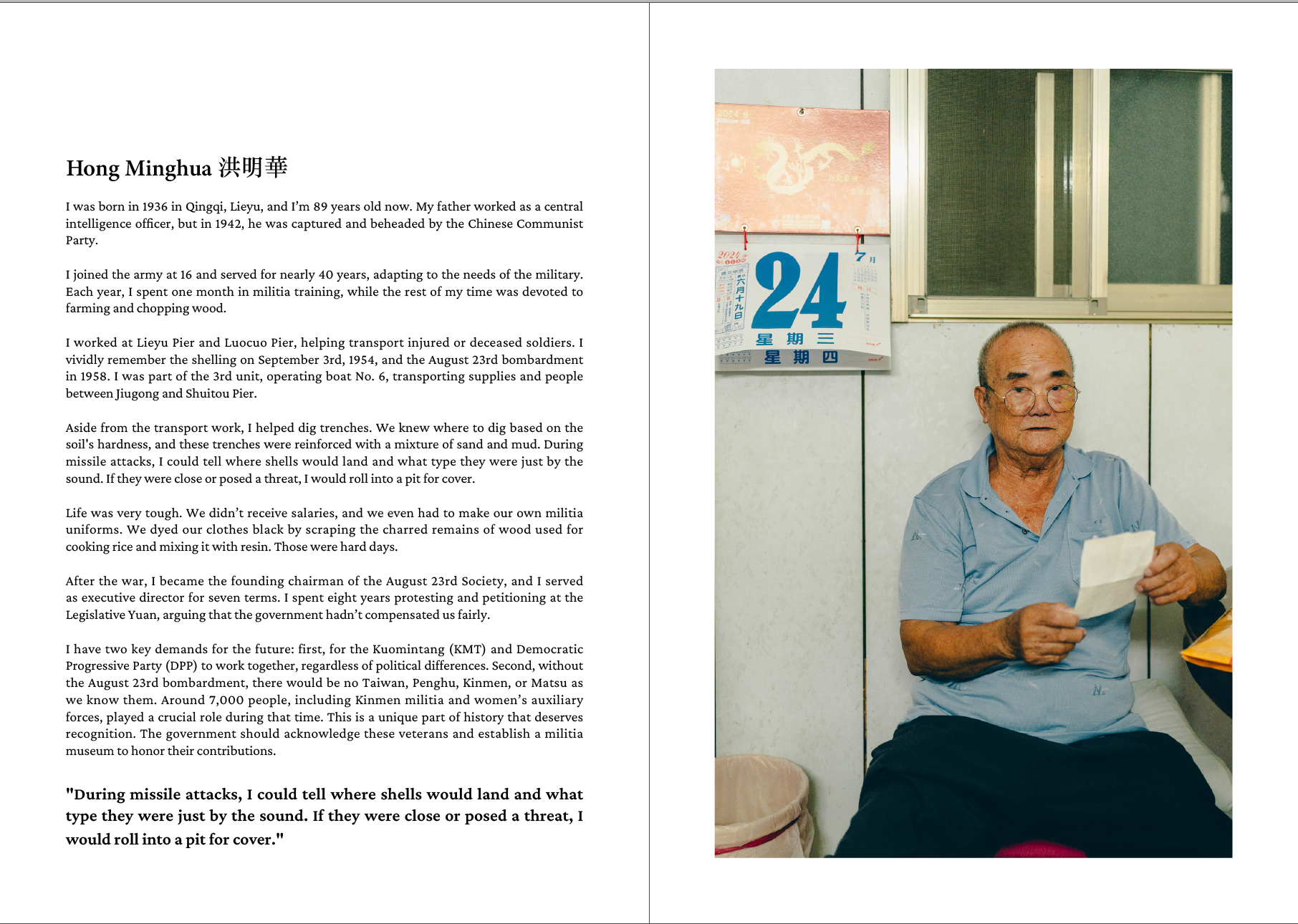


This section shifts the focus to the people of Kinmen, specifically the civil defense forces during the war. These forces were part of the larger wartime structure, and the "Everyone a Soldier" initiative meant that all residents participated in various wartime duties. Following the Battle of Guningtou in 1949, a systematic civil defense framework was established. Men aged 18 to 45 were organized into task forces, unmarried women aged 18 to 35 formed women’s teams, and boys aged 12 to 15 were grouped into children’s teams. Their routine responsibilities included drill training, road construction, and trench digging. During wartime, their duties expanded to providing medical aid to the wounded and offering logistical support during beach landings—all without salary compensation.
"War is cruel
We can't fight against China's vastness with our small space
A single nuclear bomb could wipe us out
I hope we never see war again." (Chen Yongshou,2024)
It wasn’t until November 7, 1992, when martial law was lifted and wartime governance ended, that the Kinmen Self-Defense Corps was gradually downsized and eventually disbanded. As part of this project, I interviewed six civil defense personnel, gathering their personal stories and perspectives on the wartime experience, as well as their views on the political future of Taiwan and China. The chapter's title, Counterattack the Mainland, references a slogan used by the Kuomintang during the war, emphasizing the emotional weight of this period for those who lived through it and their ongoing reflections on the cross-strait tensions.
Through their shared experiences, these individuals bridge the past and present. One veteran reflected, "If ships and troops come, how can the thousands of people in Kinmen defend themselves? We wouldn’t be able to fight back at all." (Lu Bingding ,2024) This quote highlights the deep vulnerability they felt despite their role in the defense. Another recalled, “During missile attacks, I could tell where shells would land and what type they were just by the sound. If they were close or posed a threat, I would roll into a pit for cover.” (Hong Minghua,2024) These memories of constant threat and survival underscore the traumatic effects of war, shaping their identity as both survivors and witnesses of history.
Despite their physical hardships, the veterans’ reflections also speak to a sense of collective resilience. One veteran remarked, “During military exercises, we would sing 'Counterattack the Mainland' to boost morale and win the hearts of the people.” This emotional rallying cry reveals how war, despite its cruelty, was also a time for strengthening national identity and solidarity.
These stories not only serve as a bridge to the past but also illuminate how memories of war inform present-day identities and geopolitical perspectives. The reflections of these civil defense veterans challenge simplified narratives of unity, revealing the complex, deeply personal scars that underpin broader political tensions. Their experiences highlight the enduring influence of history on contemporary cross-strait relations, demonstrating that understanding and reconciliation require confronting these shared yet deeply individualized memories.
"The blood of those who died for their country, the tears of those exiled
gradually, they are being submerged and forgotten."
(巨流河 by Chi Pang-yuan, pp. 8-9.)
(巨流河 by Chi Pang-yuan, pp. 8-9.)
Chapter 3: Anti-War Narrative - There Is No True Victor in War
In this final chapter, I delve into some of the remnants of war, such as sunken tanks buried in the sand, bunkers, tunnels, monuments, and propaganda broadcast walls—that stand as silent witnesses to history. These physical remnants offer a tangible connection to the past, each piece telling a fragment of a larger story of conflict and loss. Though Kinmen is no longer a battlefield, these structures endure, etched into the landscape as scars of war. They urge us to reflect on the devastation that war leaves behind—not only the destruction of the present but also the burdens carried forward into the future. Who, if anyone, emerges as the victor? Ultimately, no one does.


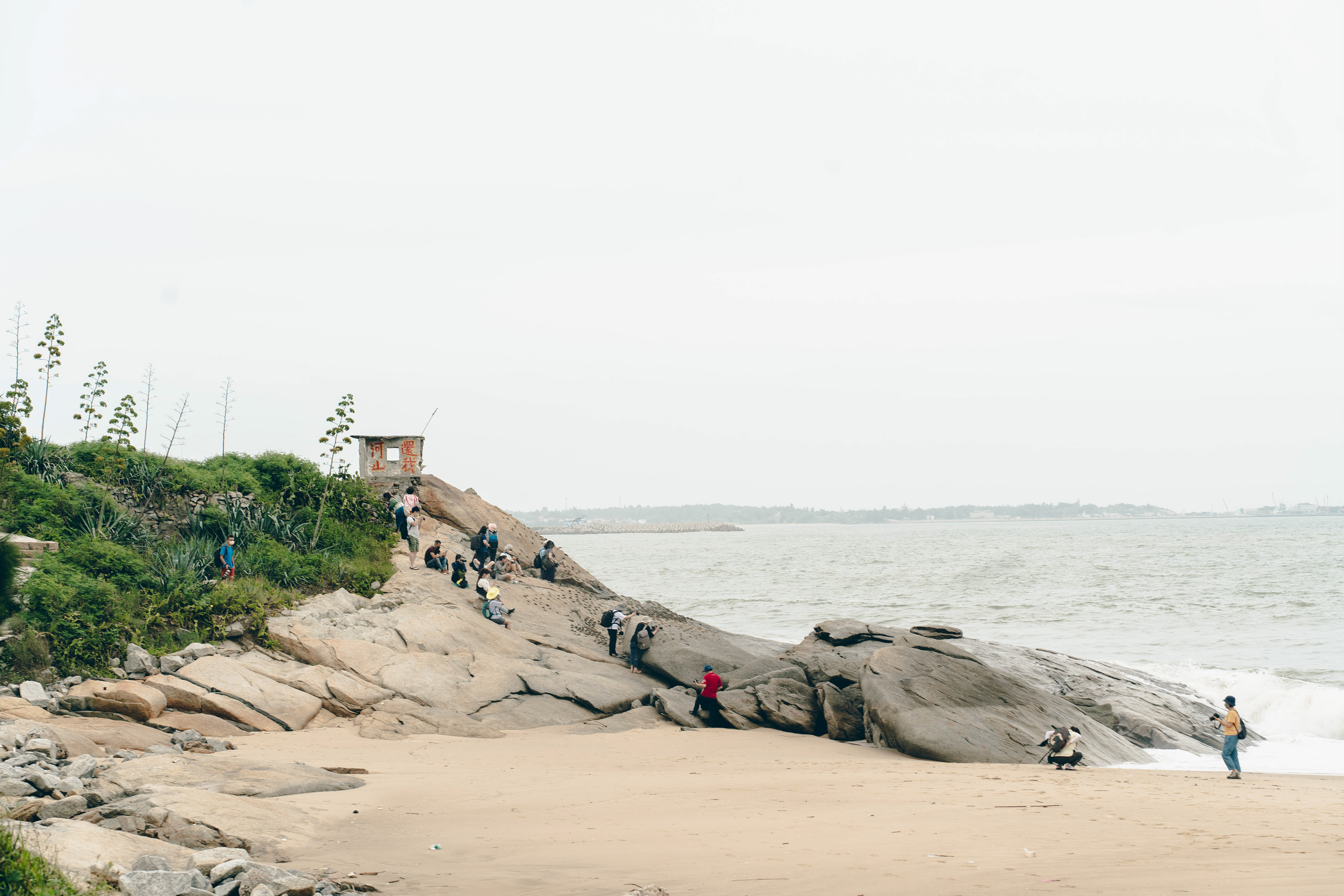
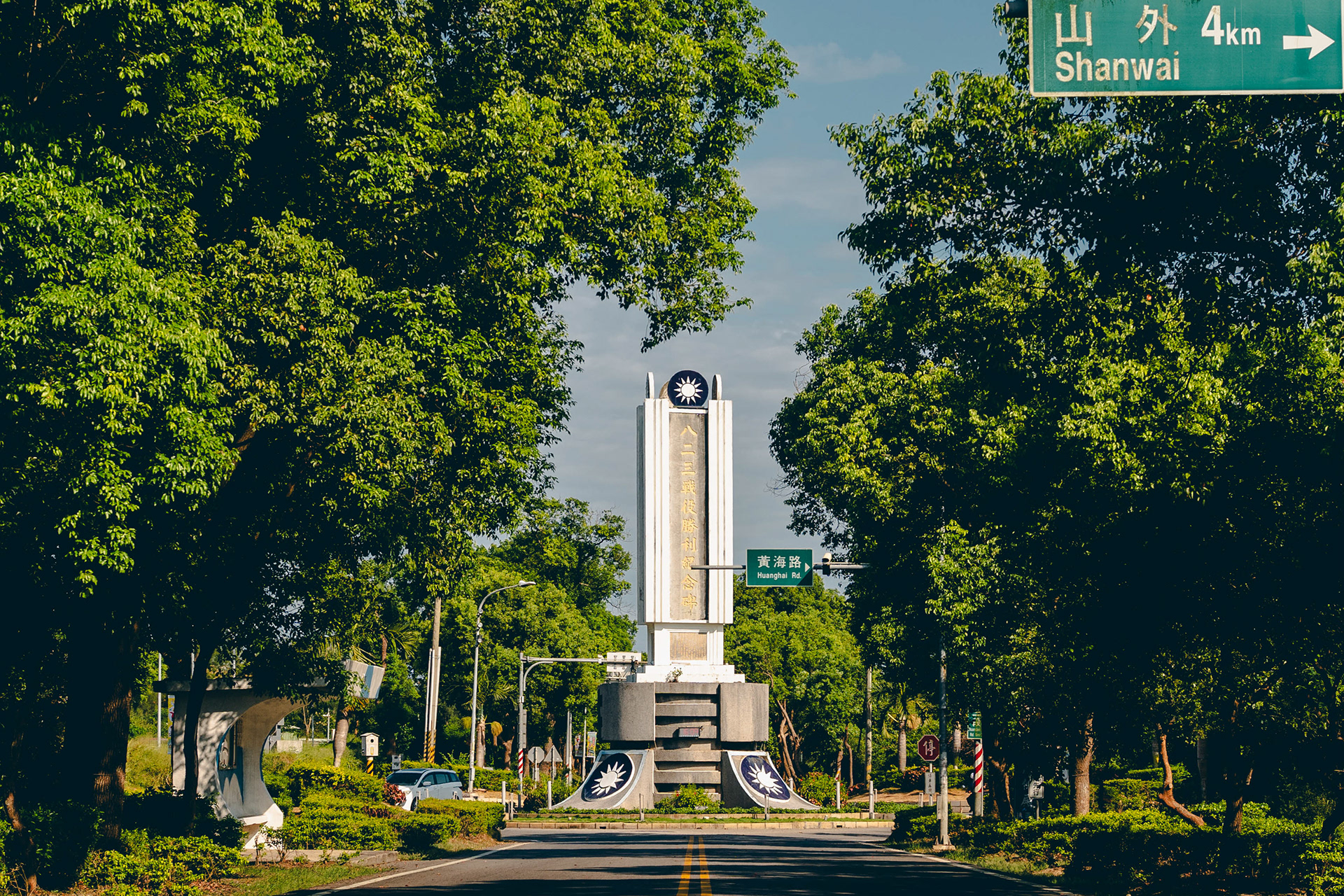
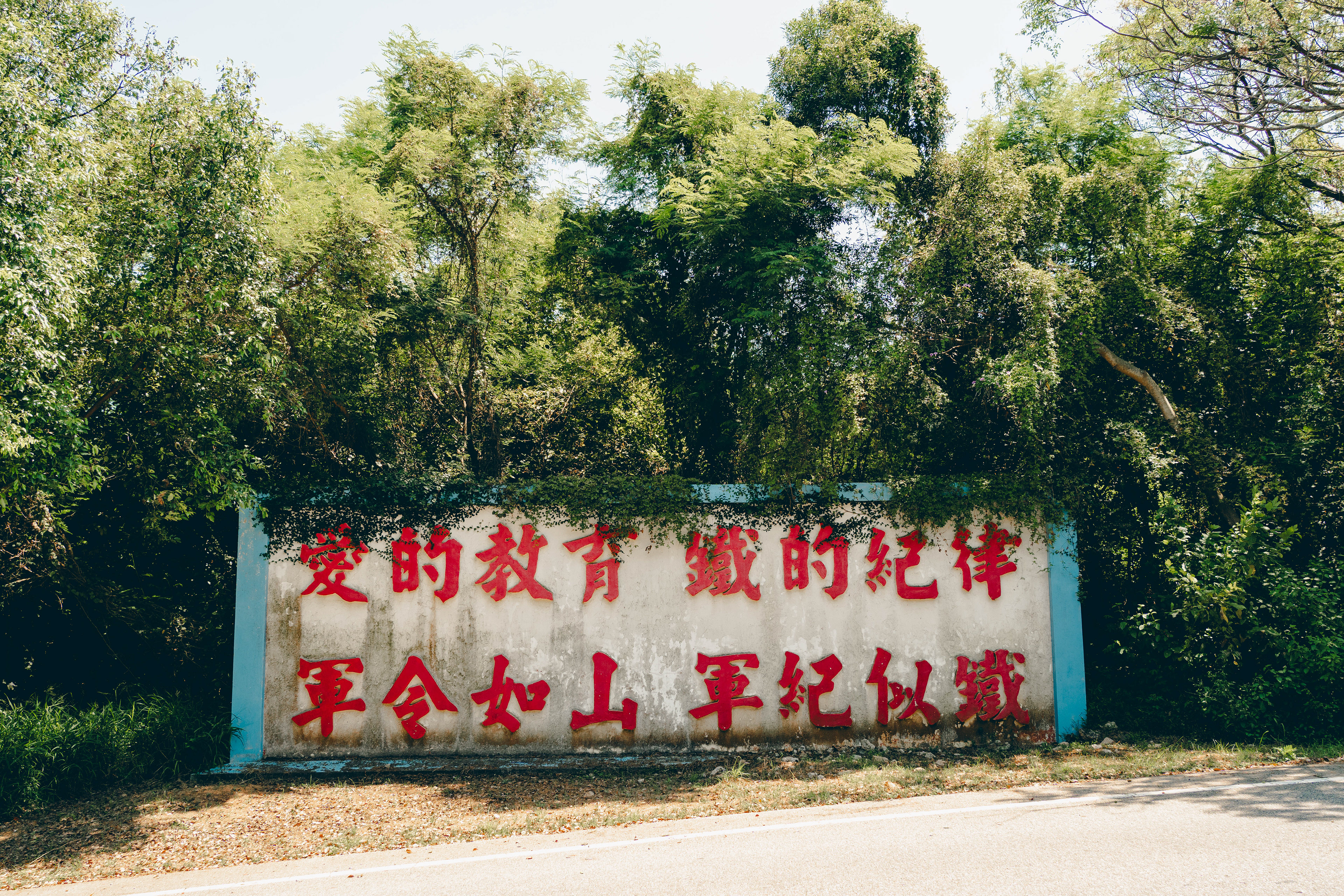

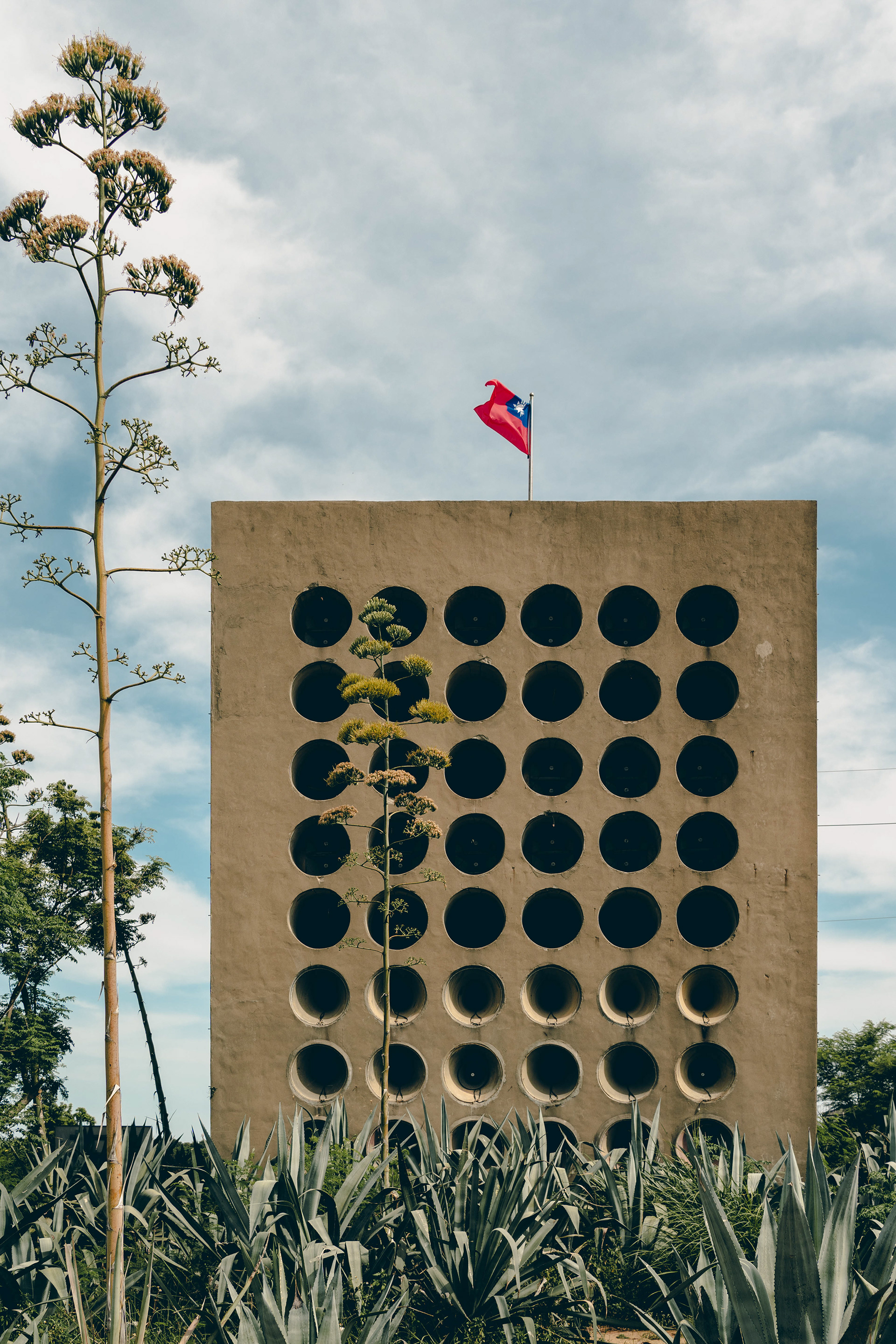
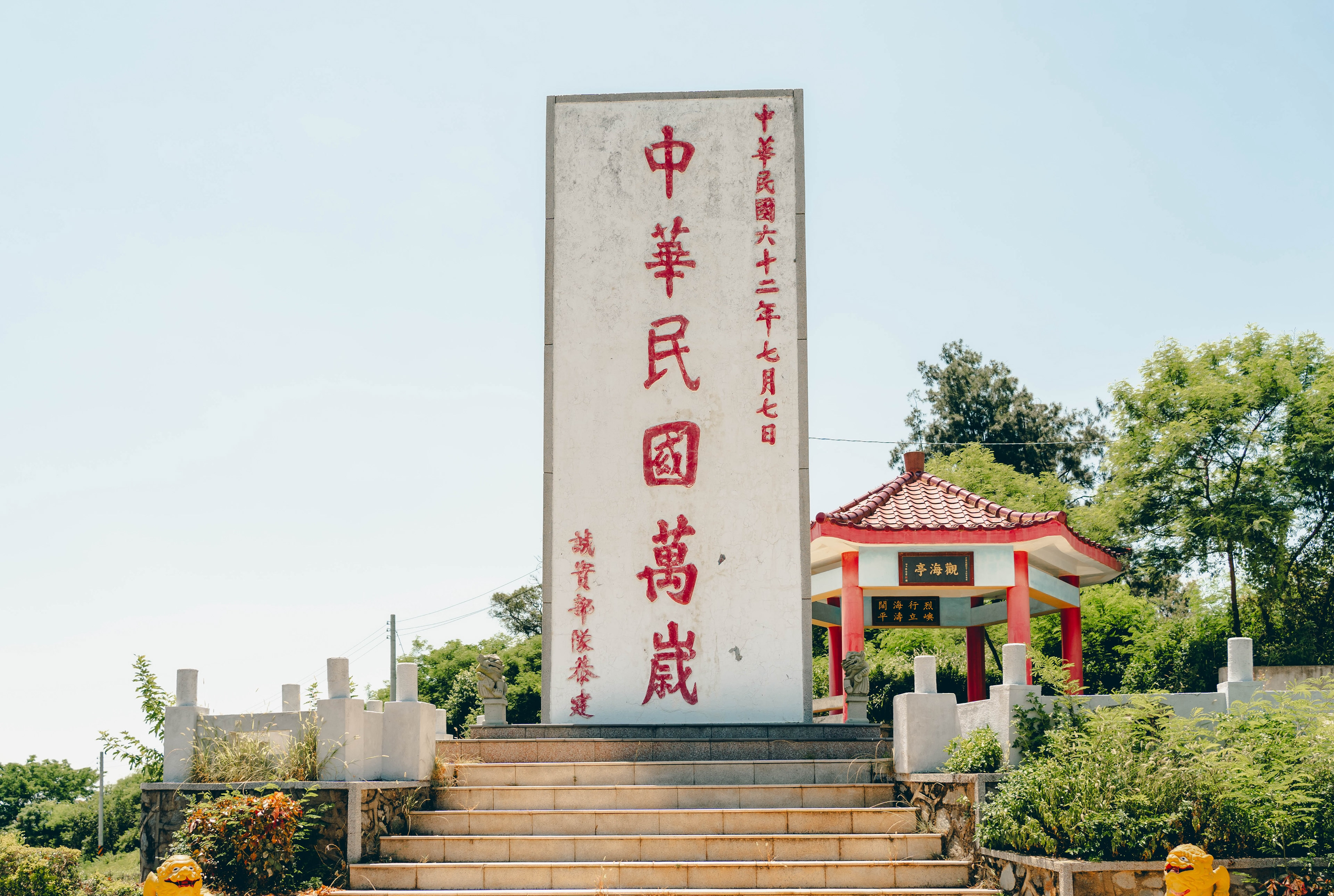
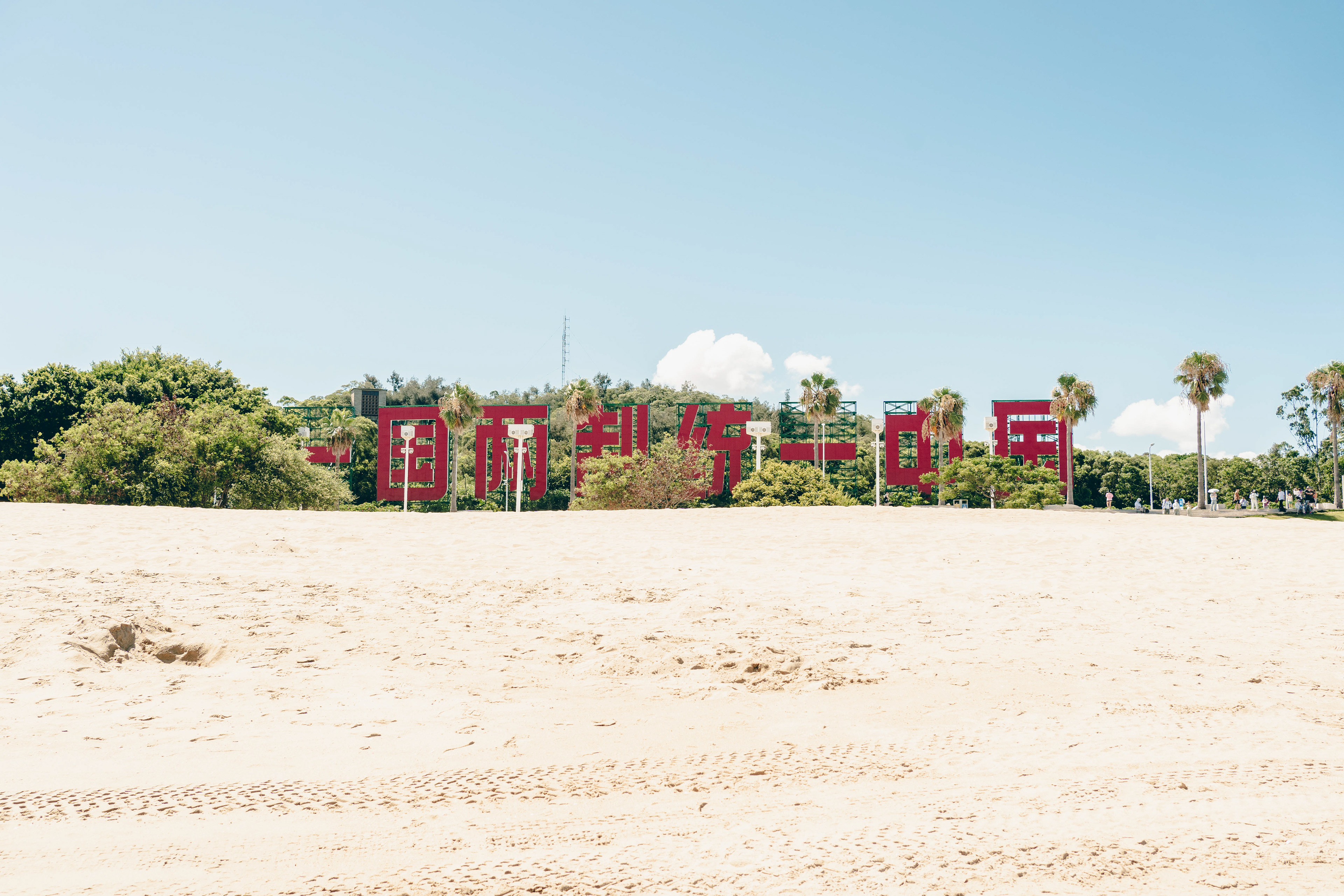
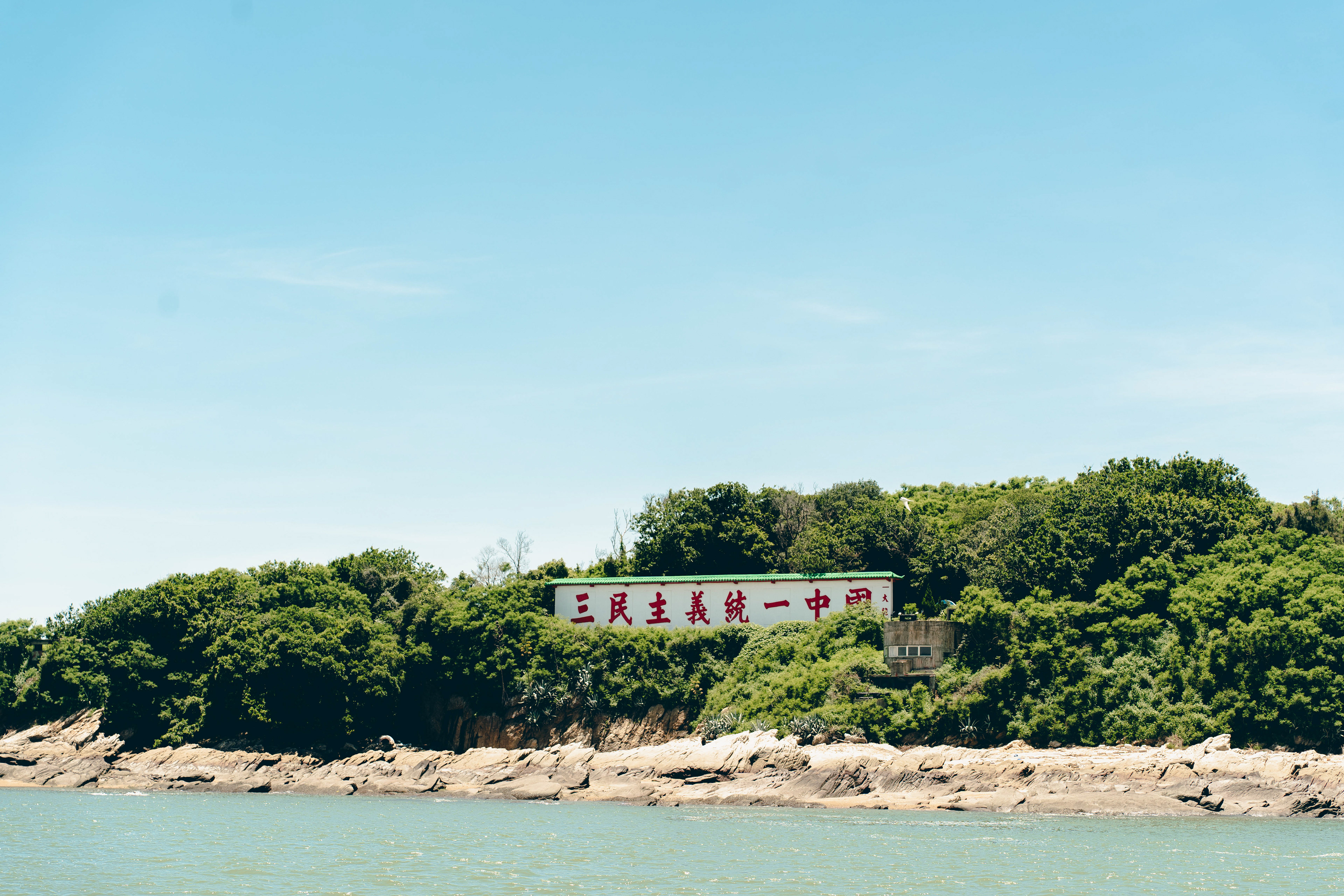
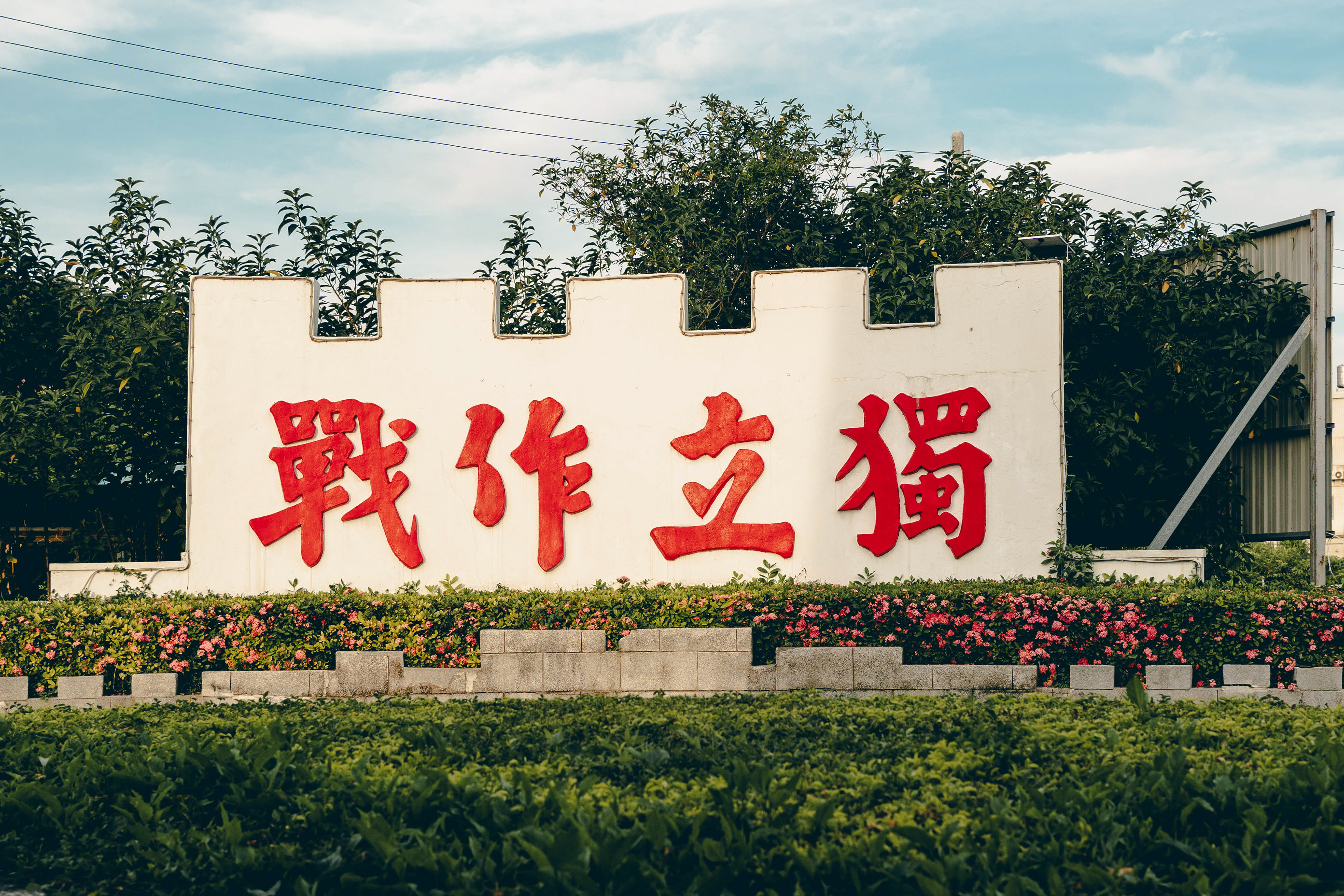


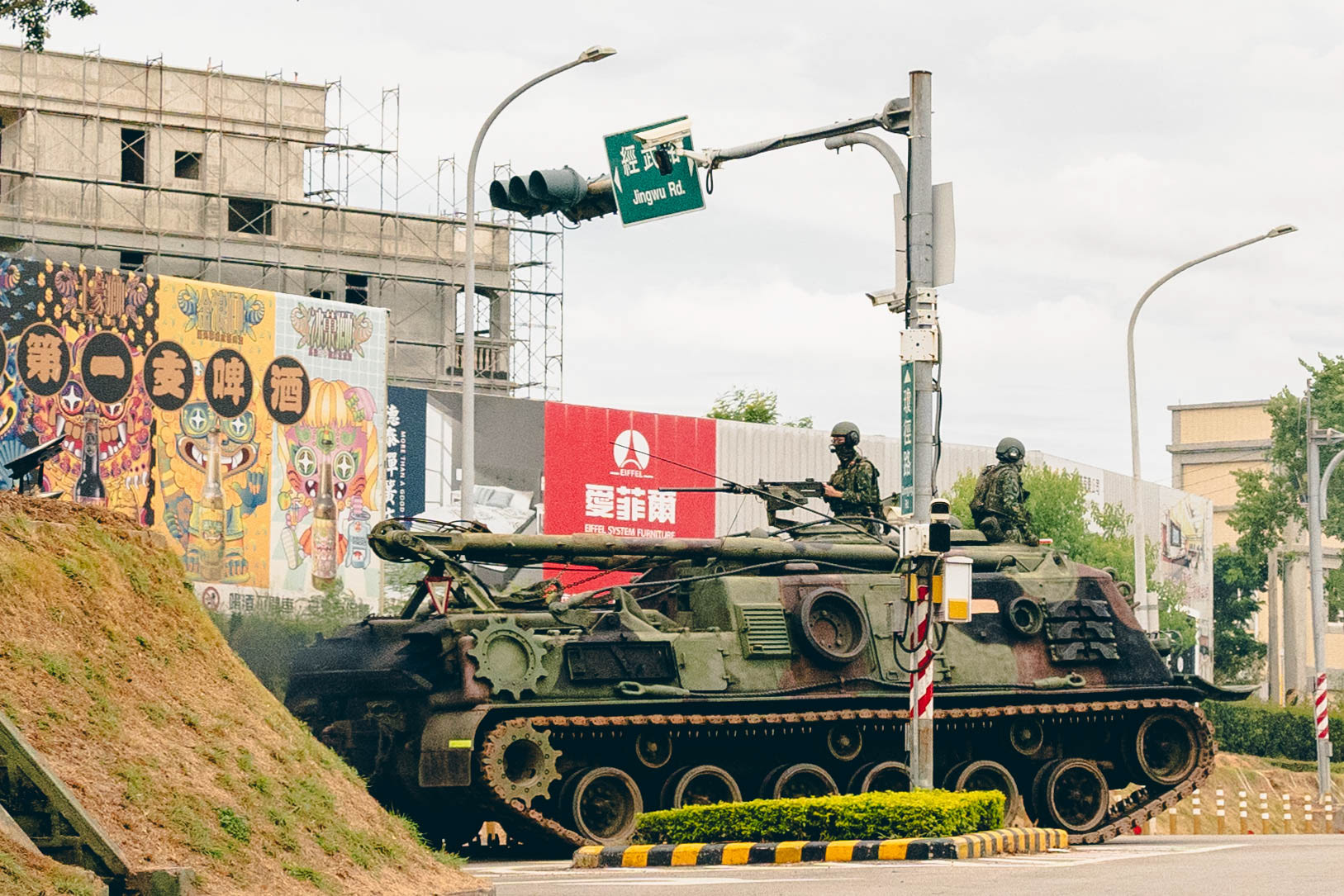
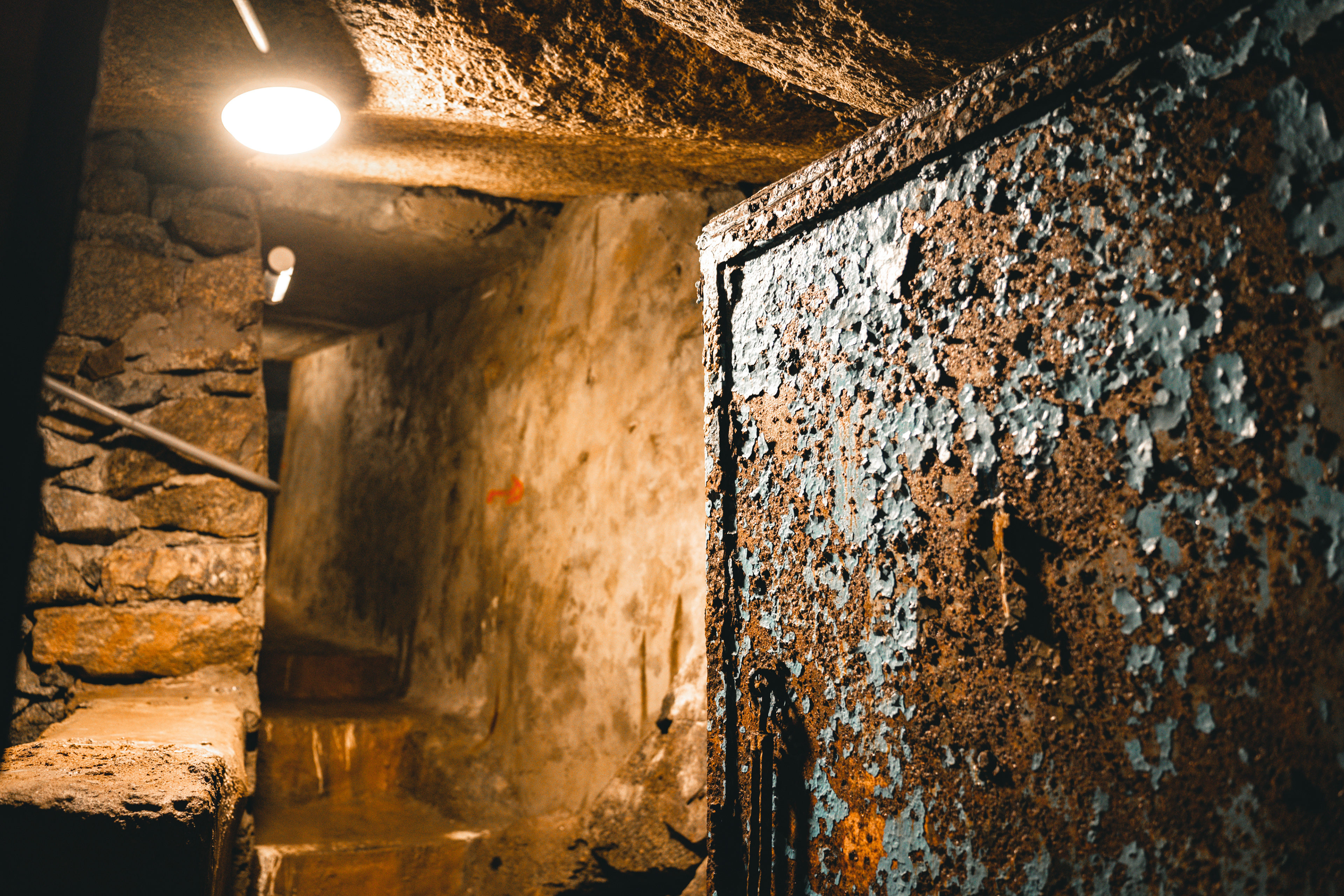
As a Taiwanese artist, my perspective is deeply rooted in Kinmen’s history, shaped by the complexities of Taiwan-China relations. Kinmen, positioned between two nations, reveals the enduring divides in culture, politics, and ideology across the Taiwan Strait. Despite their proximity, understanding remains elusive without genuine dialogue beyond headlines and surface-level exchanges.
This project carries a clear message: healing and progress can only come from confronting the past honestly, fostering meaningful dialogue, and breaking down barriers.
”Echoes of Silence“ amplifies the voices of those who lived through war while listening to the silence that remains—a space filled with memories of survival, resistance, and an unyielding hope for peace. In this silence, we find a call to empathy, understanding, and the urgent need to envision a future beyond division.